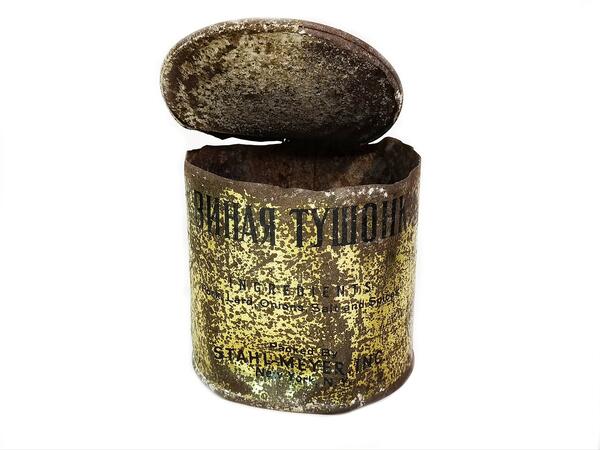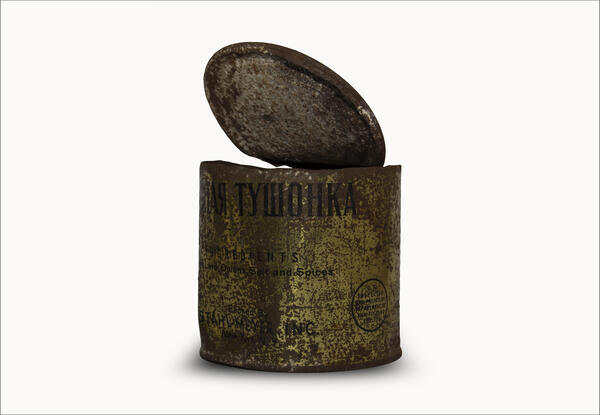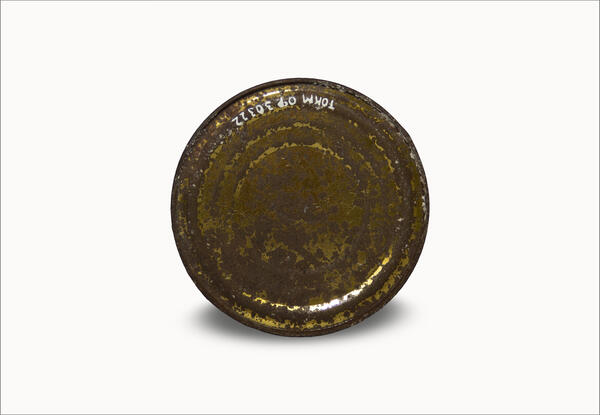The can jar with an inscription in Cyrillic characters “СВИНАЯ ТYШОНКА” (PORK STEW) from the museum’s collection was produced by the American company Stahl-Meyer Inc. This concern dates back to 1836 when its forerunner — F.A. Ferris & Company — was formed in New York.
In 1894, Louis Meyer founded Louis Meyer & Company, and in 1895, Otto Stahl established Otto Stahl & Company, which was engaged in the production of smoked meat and other meat products. In 1928, all three firms merged into a single concern.
The company produced bacon, ham, frankfurters, various kinds of sausages, bolognese sauce and many other meat products. The concern survived the Great Depression in the United States and remained a major player in the meat products market until the mid-1960s.
During World War II, under the Lend Lease Act, all major firms were involved in deliveries to the Allies, including Stahl-Meyer Inc., Kroger Grocery and Baking Company, and others. The full name of the Lend Lease Act is “An Act to Promote the Defense of the United States”. It was adopted by the US Congress on March 11, 1941 and provided material assistance to the British Empire, with other recipient states included later. The Soviet Union joined the program in December 1941.
Each can of stew contained 11.5 ounces of produce, i.e., 342 grams of pork, fat, granulated onions, salt, and spices. All batches were inspected by the United States Department of Agriculture. Within the food lend lease for the USSR, about 665 thousand tons accounted for canned meat. Most of that went to the needs of the Red Army.
In addition to food, military equipment was supplied to the USSR under the program: aircraft, tanks, and self-propelled guns, as well as explosives and gunpowder, aluminum, aviation gasoline, cars, and army clothing. At present, there are different points of view on the importance of the contribution of the aid program under the Lend Lease Act to the success of the Soviet army in the Great Patriotic War. Some researchers believe that it was instrumental for the victory, while others (evaluating more factors than just the statistics of manufacture in the USSR) come to the conclusion that the significance of Lend Lease is greatly overestimated.
In 1894, Louis Meyer founded Louis Meyer & Company, and in 1895, Otto Stahl established Otto Stahl & Company, which was engaged in the production of smoked meat and other meat products. In 1928, all three firms merged into a single concern.
The company produced bacon, ham, frankfurters, various kinds of sausages, bolognese sauce and many other meat products. The concern survived the Great Depression in the United States and remained a major player in the meat products market until the mid-1960s.
During World War II, under the Lend Lease Act, all major firms were involved in deliveries to the Allies, including Stahl-Meyer Inc., Kroger Grocery and Baking Company, and others. The full name of the Lend Lease Act is “An Act to Promote the Defense of the United States”. It was adopted by the US Congress on March 11, 1941 and provided material assistance to the British Empire, with other recipient states included later. The Soviet Union joined the program in December 1941.
Each can of stew contained 11.5 ounces of produce, i.e., 342 grams of pork, fat, granulated onions, salt, and spices. All batches were inspected by the United States Department of Agriculture. Within the food lend lease for the USSR, about 665 thousand tons accounted for canned meat. Most of that went to the needs of the Red Army.
In addition to food, military equipment was supplied to the USSR under the program: aircraft, tanks, and self-propelled guns, as well as explosives and gunpowder, aluminum, aviation gasoline, cars, and army clothing. At present, there are different points of view on the importance of the contribution of the aid program under the Lend Lease Act to the success of the Soviet army in the Great Patriotic War. Some researchers believe that it was instrumental for the victory, while others (evaluating more factors than just the statistics of manufacture in the USSR) come to the conclusion that the significance of Lend Lease is greatly overestimated.






